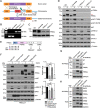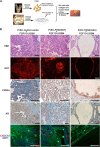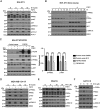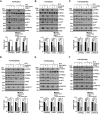Pharmacologically targeting the myristoylation of the scaffold protein FRS2α inhibits FGF/FGFR-mediated oncogenic signaling and tumor progression
- PMID: 29540482
- PMCID: PMC5925806
- DOI: 10.1074/jbc.RA117.000940
Pharmacologically targeting the myristoylation of the scaffold protein FRS2α inhibits FGF/FGFR-mediated oncogenic signaling and tumor progression
Abstract
Fibroblast growth factor (FGF)/FGF receptor (FGFR) signaling facilitates tumor initiation and progression. Although currently approved inhibitors of FGFR kinase have shown therapeutic benefit in clinical trials, overexpression or mutations of FGFRs eventually confer drug resistance and thereby abrogate the desired activity of kinase inhibitors in many cancer types. In this study, we report that loss of myristoylation of fibroblast growth factor receptor substrate 2 (FRS2α), a scaffold protein essential for FGFR signaling, inhibits FGF/FGFR-mediated oncogenic signaling and FGF10-induced tumorigenesis. Moreover, a previously synthesized myristoyl-CoA analog, B13, which targets the activity of N-myristoyltransferases, suppressed FRS2α myristoylation and decreased the phosphorylation with mild alteration of FRS2α localization at the cell membrane. B13 inhibited oncogenic signaling induced by WT FGFRs or their drug-resistant mutants (FGFRsDRM). B13 alone or in combination with an FGFR inhibitor suppressed FGF-induced WT FGFR- or FGFRDRM-initiated phosphoinositide 3-kinase (PI3K) activity or MAPK signaling, inducing cell cycle arrest and thereby inhibiting cell proliferation and migration in several cancer cell types. Finally, B13 significantly inhibited the growth of xenograft tumors without pathological toxicity to the liver, kidney, or lung in vivo In summary, our study suggests a possible therapeutic approach for inhibiting FGF/FGFR-mediated cancer progression and drug-resistant FGF/FGFR mutants.
Keywords: B13; FRS2; cancer; drug action; fibroblast growth factor (FGF); fibroblast growth factor receptor (FGFR); myristoylation; protein acylation.
© 2018 by The American Society for Biochemistry and Molecular Biology, Inc.
Conflict of interest statement
The authors declare that they have no conflicts of interest with the contents of this article
Figures







Similar articles
-
Myristoylation-Dependent Palmitoylation of the Receptor Tyrosine Kinase Adaptor FRS2α.Biochemistry. 2019 Jun 25;58(25):2809-2813. doi: 10.1021/acs.biochem.9b00299. Epub 2019 Jun 11. Biochemistry. 2019. PMID: 31184863 Free PMC article.
-
The inositol phosphatase SHIP2 enables sustained ERK activation downstream of FGF receptors by recruiting Src kinases.Sci Signal. 2018 Sep 18;11(548):eaap8608. doi: 10.1126/scisignal.aap8608. Sci Signal. 2018. PMID: 30228226
-
Amplification of FRS2 and activation of FGFR/FRS2 signaling pathway in high-grade liposarcoma.Cancer Res. 2013 Feb 15;73(4):1298-307. doi: 10.1158/0008-5472.CAN-12-2086. Epub 2013 Feb 7. Cancer Res. 2013. PMID: 23393200
-
Implications of Fibroblast Growth Factors (FGFs) in Cancer: From Prognostic to Therapeutic Applications.Curr Drug Targets. 2019;20(8):852-870. doi: 10.2174/1389450120666190112145409. Curr Drug Targets. 2019. PMID: 30648505 Review.
-
Small molecule inhibition of fibroblast growth factor receptors in cancer.Cytokine Growth Factor Rev. 2013 Oct;24(5):467-75. doi: 10.1016/j.cytogfr.2013.05.002. Epub 2013 Jul 2. Cytokine Growth Factor Rev. 2013. PMID: 23830577 Review.
Cited by
-
Comprehensive analysis of potential cellular communication networks in advanced osteosarcoma using single-cell RNA sequencing data.Front Genet. 2022 Oct 11;13:1013737. doi: 10.3389/fgene.2022.1013737. eCollection 2022. Front Genet. 2022. PMID: 36303551 Free PMC article.
-
Regulation of FGF10 Signaling in Development and Disease.Front Genet. 2018 Oct 23;9:500. doi: 10.3389/fgene.2018.00500. eCollection 2018. Front Genet. 2018. PMID: 30405705 Free PMC article. Review.
-
Protein lipidation in the tumor microenvironment: enzymology, signaling pathways, and therapeutics.Mol Cancer. 2025 May 7;24(1):138. doi: 10.1186/s12943-025-02309-7. Mol Cancer. 2025. PMID: 40335986 Free PMC article. Review.
-
Inhibition of N-myristoyltransferase activity promotes androgen receptor degradation in prostate cancer.Prostate. 2024 Feb;84(3):254-268. doi: 10.1002/pros.24645. Epub 2023 Oct 31. Prostate. 2024. PMID: 37905842 Free PMC article.
-
Expression of FRS2 in atypical lipomatous tumor/well-differentiated liposarcoma and dedifferentiated liposarcoma: an immunohistochemical analysis of 182 cases with genetic data.Diagn Pathol. 2021 Oct 25;16(1):96. doi: 10.1186/s13000-021-01161-9. Diagn Pathol. 2021. PMID: 34696768 Free PMC article.
References
-
- Dieci M. V., Arnedos M., Andre F., and Soria J. C. (2013) Fibroblast growth factor receptor inhibitors as a cancer treatment: from a biologic rationale to medical perspectives. Cancer Discov. 3, 264–279 10.1158/2159-8290.CD-12-0362 - DOI - PubMed
Publication types
MeSH terms
Substances
Grants and funding
LinkOut - more resources
Full Text Sources
Other Literature Sources
Medical
Molecular Biology Databases

